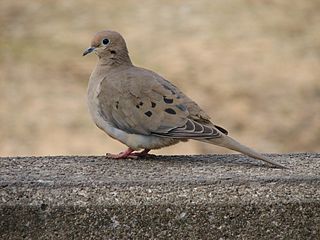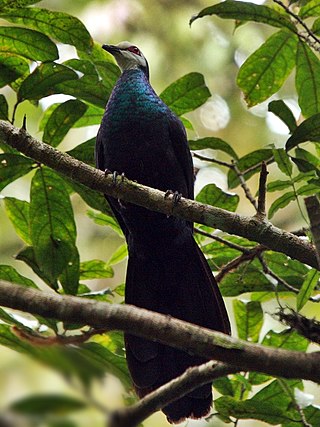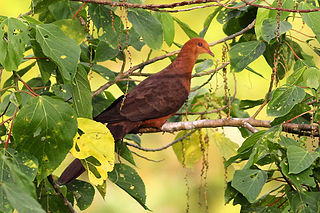
The vinaceous dove is a bird species in the pigeon family Columbidae that widely resident across the Sahel and Sudan (region).

Streptopelia is a genus of 15 species of birds in the pigeon and dove family Columbidae native to the Old World in Africa, Europe, and Asia. These are mainly slim, small to medium-sized species. The upperparts tend to be buffy brown and the underparts are often a shade of pinkish-brown, and they have a characteristic black-and-white patch on the neck. They have cooing or purring songs, monotonous in some, restful and soothing in others. The genus divides into two groups, the collared dove group with uniform upperparts and a black half-collar edged with white, and the turtle dove group with patterned upperparts and a barred side panel on the neck. They range in size from the 20–23 cm red collared dove to the 33–35 cm oriental turtle dove. Most of the species are resident or disperse over short distances, but two are long-distance migrants breeding in temperate areas and wintering in the tropics. The sexes are not differentiated in most of the species, except for the red collared dove, where the males are orange-red with a greyish head, and the females a duller brown.

Hemiphaga is the genus containing two species of large pigeons from New Zealand.

The zenaida doves make up a small genus (Zenaida) of American doves in the family Columbidae.

Turacoena is a small genus of doves in the family Columbidae that are found in Indonesia.

The red collared dove, also known as the red turtle dove, is a small pigeon which is a resident breeding bird in the tropics of Asia. The male has a blue-grey head and a red-brown body. The female is much plainer, with pale brown plumage similar to that of the larger Eurasian collared dove.

The Amboyna cuckoo-dove is a dove in the genus Macropygia found in the Moluccas and New Guinea. It was one of three new species defined when the slender-billed cuckoo-dove was split up in 2016 and retains the Latin binomial of the former species.[1]

Chalcopsitta is a genus of parrot in the family Psittaculidae and the subfamily Loriinae. All three species are native to New Guinea and western offshore islands. The name Chalcopsitta is derived from the Greek khalkos meaning "bronze" and psitta meaning "parrot".

The shining parrots, Prosopeia, are a genus of parrots in the family Psittaculidae.

The cinnamon-bellied imperial pigeon or cinnamon imperial pigeon is a species of bird in the family Columbidae. It is endemic to the northern Moluccas. Its natural habitat is subtropical or tropical moist lowland forests.

The white-bellied imperial pigeon is a species of bird in the pigeon family Columbidae. First described by the French ornithologist Charles Lucien Bonaparte in 1854, it is endemic to Indonesia, where it is found on Sulawesi, Buton, Taliabu, Togian, and Peleng. It inhabits primary forest, dense secondary forest, and isolated areas of hill forest. A large pigeon with a long tail, it measures 42.5–51.5 cm (16.7–20.3 in) long and weighs 510 g (18 oz) on average. Males are mainly green, with pale-grey heads and bellies, chestnut vents, and a pale grey tail band, along with a red orbital ring. Females are nearly identical, but have darker grey areas in their plumage.

The ruddy cuckoo-dove is a species of bird in the family Columbidae. It is a medium-sized, reddish brown cuckoo-dove, found in Brunei, Indonesia, and Malaysia. It is rated as a species of least concern on the International Union for Conservation of Nature Red List of Endangered Species.

Macropygia is a genus of bird in the pigeon and dove family Columbidae. The genus is one of three genera known as cuckoo-doves. They are long tailed, range between 27 and 45 cm in length and have brown plumage. The genus now ranges from India and China through Indonesia and the Philippines to Vanuatu and Australia, though they originated from North and South America.

The Philippine cuckoo-dove is a species of bird in the family Columbidae. It is found in the Philippines and Taiwan and is rated as a species of least concern on the International Union for Conservation of Nature Red List of Endangered Species.

Metriopelia is a genus of ground doves containing four species that live in the dry, upland habitats along the Andean mountain chain in South America. They have large wings and three species have orange skin around the eyes.

Brown doves are members of the genus Phapitreron in the pigeon family. Their common name refers to their overall brown coloration. They are endemic to the Philippines. All brown doves are tree-dwellers, but the different species occupy different types of wooded habitats; some are more restricted to old-growth forest while other make use of secondary forest and other woodland. Their main diet is fruit. They tend to be solitary in their habits and can be elusive. Some species in this genus have conspicuous black and white stripes on their faces and iridescent neck feathers. Males and females look alike.

The pied cuckoo-dove is a species of bird in the pigeon family, Columbidae. First described by English zoologist Philip Sclater in 1877, it is endemic to the Bismarck Archipelago, where it mainly inhabits lowland and hill forests at elevations of up to 1,000 m (3,300 ft). It is a large, distinctive pigeon, with a length of 40–46 cm (16–18 in) and a weight of 279–325 g (9.8–11.5 oz). Adults are mainly black and white. The heads and underparts are whitish, while the wings, tails, and upperparts are black. Both sexes look alike. Juveniles are mainly sooty-grey in colour.

The crested cuckoo-dove is a species of bird in the pigeon family, Columbidae. First described by English zoologist John Gould in 1856, it is endemic to the Solomon Islands archipelago, where it mainly inhabits hill forests at elevations of 500–900 m (1,600–3,000 ft). It is a large and robust pigeon, with a length of 40–42 cm (16–17 in) and a distinctive pale purplish-grey crest. Adults are mainly bluish-grey, with a pale greyish-buff throat, blackish tail, and yellow-tipped reddish bill. Both sexes look alike. Juveniles lack the crest, have darker heads, and have duller wings.

The great cuckoo-dove is a species of bird in the pigeon family, Columbidae. First described by the Dutch zoologist Coenraad Jacob Temminck in 1824, it is found on New Guinea, several surrounding islands, and Wallacea, where it mainly inhabits primary forest and the forest edge. It is a large, distinctive pigeon, with a length of 47.5–52.5 cm (18.7–20.7 in) and a weight of 208–305 g (7.3–10.8 oz). In adults, the head, neck, and breast are whitish or blue-grey, the underparts are pale bluish-grey, the upperparts are chestnut-brown, and the outer wings are black. Females differ from males in having more yellowish irises and duller orbital skin. Juveniles are mainly dull grey-brown, with dirty-white throats and bellies.

The blue-headed quail dove, or blue-headed partridge-dove, is a species of bird in the pigeon and dove family Columbidae. It is monotypic within the subfamily Starnoenadinae and genus Starnoenas.





















